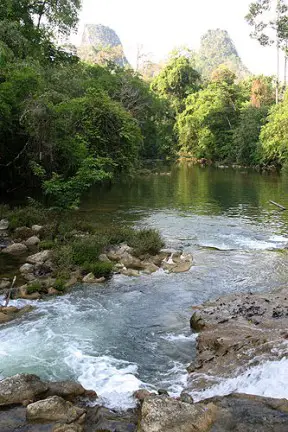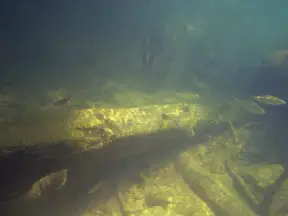Garra sp. 'redtail'
Burmese Red-tailed Garra
Etymology
Garra: vernacular Gangetic name for a particular species of “sand-digger,” which Francis Buchanan-Hamilton applied as a generic name for bottom-dwelling cyprinids “with no affinity to another genus”.
Classification
Order: Cypriniformes Family: Cyprinidae
Distribution
Appears to be endemic to headwaters of the Salween River basin around the border between Myanmar and Thailand, where it’s known from the upper Ataran and Hanthayaw watersheds.
In Thailand the Ataran and Hantayaw are known as the Kasat and Suriya, respectively, and are located in the Thung Yai Naresuan and Huai Kha Khaeng wildlife sanctuaries. These covers parts of Kanchanaburi, Tak and Uthai Thani provinces and represent one of the few remaining pockets of pristine forest in the country.
Habitat
Inhabits shady, fast-flowing stretches and riffles but is also found in deeper pools at times. Such headwaters are well-oxygenated with clear water, a substrate comprising sand, gravel, rocks, boulders and patches of leaf litter with a rich biofilm normally carpeting solid surfaces. Submerged driftwood and the roots of marginal vegetation are also typical features.
Aquatic plants such as Cryptocoryne crispatula var. balansae and Pogostemon helferi grow in stiller parts of these well-oxygenated habitats. Other fish species occuring in the two drainages and which may occur sympatrically include Parambassis pulcinella, Botia kubotai, Acanthocobitis pictilis, Schistura maepaiensis, Homaloptera modesta, Syncrossus berdmorei, Pangio fusca, Pethia stoliczkana, Microdevario kubotai, Crossocheilus burmanicus, Akysis vespa, Glyptothorax dorsalis, Amblyceps caecutiens, Batasio feruminatus, B. dayi, Caelatoglanis zonatus, Psilorhynchus robustus and Tetraodon cutcutia.
Maximum Standard Length
65 – 75 mm.
Aquarium SizeTop ↑
An aquarium with base measurements of 120 ∗ 30 cm should be the smallest considered.
Maintenance
Not difficult to keep in a well-maintained set-up, but a display arranged to resemble a flowing stream or river, with a substrate of variably-sized, water-worn rocks, sand, fine gravel and perhaps some small boulders, is highly recommended. This can be further furnished with driftwood roots or branches, and hardy aquatic plants such as Microsorum, Bolbitis, or Anubias spp., which can be grown attached to items of décor.
Most importantly, the water must be clean and well-oxygenated with turnover preferably in excess of 10 times per hour; additional powerheads and airstones can be employed to achieve the desired flow and oxygenation if necessary. Bright lighting will promote development of biofilm on solid surfaces, upon which the fish will graze.
Since it needs stable water conditions and grazes biofilm this species should never be added to a biologically immature set-up, and a tightly-fitting cover is necessary since it can literally climb glass.
Water Conditions
Temperature: 20 – 27 °C
pH: 6.0 – 7.5
Hardness: 18 – 215 ppm
Diet
Although it will graze algae if available this species is not an exclusive herbivore. Offer meaty foods such as live or frozen chironomid larvae (bloodworm), Tubifex, Artemia, chopped prawn, etc., along with good quality, sinking dried products, at least some of which should contain a significant proportion of vegetable matter such as Spirulina or similar.
Fresh fruit and vegetables such as cucumber, melon, blanched spinach or courgette can be offered occasionally and home-made, gelatine-bound recipes containing a mixture of dried fish food, puréed shellfish, fresh fruit and vegetables, are also proven to work well.
Behaviour and CompatibilityTop ↑
Relatively peaceful and makes a good subject for the well-chosen, larger community of stream-dwelling Indochinese species.
It isn’t particularly tolerant of conspecifics but apparently exists in loose aggregations in the wild. If kept singly it tends to behave more aggressively with similarly-shaped fishes so we recommend the purchase of 3-4 or more should space permit. Such a group will develop a noticeable pecking order between themselves but tankmates are more likely to be left alone. What appear to be hierarchical disputes will sometimes occur and involve charging, flaring of fins, an overall paling of the body colouration, and, in males, extension of the rostral process.
Sexual Dimorphism
Unconfirmed although adult females are likely to be thicker in the body than males. In many other Garra spp. sexually mature males develop more prominent head, and sometimes body, tubercules when in spawning condition.
Reproduction
Unreported.
NotesTop ↑
A putatively undescribed species often imported and sold as G. sp. ‘burmanicus’. It first appeared in the trade during 2005 and has since been available on a sporadic basis, usually with a relatively high price tag. As well as its unique colour pattern, a primary diagnostic character is the presence of a proboscis-like rostral process between the eyes.
This is flexible appears to act as an indicator of mood, becoming erect when the fish are engaged in territorial conflicts or courtship behaviour, although its precise role is unclear. The underside, visible only when the appendage is extended is light-coloured and covered in a series of tubercules suggesting it may also have a visual and/or chemical function(s).
The genus Garra is a particularly enigmatic grouping with new taxa described on a regular basis, while many of the existing ones may represent cases of misidentification or synonyms of other species. Some of the revisions have also been called into question, which has added further confusion. A full generic review would be ideal but is unlikely to materialise given the extensive distribution of its members which range from southern China across much of southeast Asia, India and the Middle East as far as north/central Africa.
Instead a number of less-extensive works published in recent years have resulted in a gradual, but continuing, improvement in knowledge, and it remains possible that the genus will be broken up into smaller taxa since the current assemblage is almost certainly polyphyletic.
Garra species are usually included in the subfamily Labeoninae/Cyprininae or tribe Labeonini (name varies with author) which by recent thinking is further divided into four subtribes; Labeoina, Garraina, Osteochilina, and Semilabeoina (Yang et al., 2012). The putatively monophyletic Garraina comprises a number of genetic lineages including Garra sensu stricto (which also includes Horalabiosa, Phreatichthys and possibly other genera), a small clade comprising Garra cambodgiensis and G. fascicauda (thus rendering Garra polyphyletic), Paracrossocheilus, and Gonorhynchus (which includes Akrokolioplax).
Two Garra species, G. imberba and G. micropulvinus, are placed in the Semilabeoina assemblage, and the generic name Ageneiogarra Garman, 1912 has been suggested for them, although this does not appear to have been widely followed (e.g. Kottelat, 2013). In addition, some genera which were previously considered to be close relatives of Garra species such as Discogobio, Discocheilus and Placocheilus, are now also placed in this subtribe.
All genera currently included in Garraina possess a lower lip modified to form a mental adhesive disc, allowing the fish to cling to surfaces in turbulent conditions. In most species the upper lip is almost entirely reduced and both the upper and lower jaw margins are keratinised, i.e., horny, and used to scrape food items from the substrate.
Garra species are distinguished from other Garraina members by the first two pectoral-fin rays usually being thickened, fleshy and unbranched, possession of 10-11 dorsal-fin rays, and a combination of internal characters. Some species have evolved particular environmental specialisms such as highly reduced eyes in hypogean forms or the ability to survive in thermal springs.
References
- Kullander, S. and F. Fang, 2004 - Ichthyological Exploration of Freshwaters 15(3): 257-278
Seven new species of Garra (Cyprinidae: Cyprininae) from the Rakhine Yoma, southern Myanmar. - Stiassny, M. L. J. and A. Getahun, 2007 - Zoological Journal of the Linnean Society 150(1): 41-83
An overview of labeonin relationships and the phylogenetic placement of the Afro-Asian genus Garra Hamilton, 1922 (Teleostei: Cyprinidae), with the description of five new species of Garra from Ethiopia, and a key to all African species. - Yang, L., M. Arunachalam, T. Sado, B. A. Levin, A. S. Golubtsov, J. Freyhof, J. P. Friel, W-J. Chen, M. V. Hirt, R. Manickam, M. K. Agnew, A. M. Simons, K. Saitoh, M. Miya, R. L. Mayden, and S. He, 2012 - Molecular Phylogenetics and Evolution 65(2): 362-379
Molecular phylogeny of the cyprinid tribe Labeonini (Teleostei: Cypriniformes). - Zhang, E., 2005 - Zoological Studies 44(1): 130-143
Phylogenetic relationships of labeonine cyprinids of the disc-bearing group (Pisces: Teleostei).









